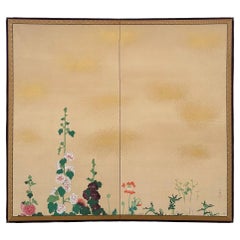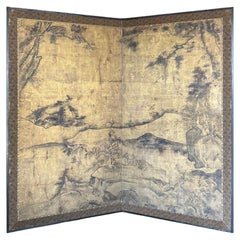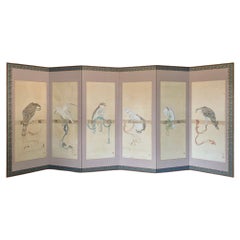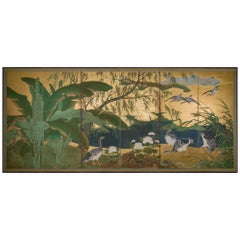Japanese Paintings and Screens
to
134
485
182
872
47
23
9
1
120
349
403
47
178
79
20
25
3
23
10
1
5
14
10
2
493
483
423
331
320
1,590
1,420
919
446
132
919
916
917
29
3
2
2
1
Place of Origin: Japanese
Showa Golden Mallow Screen
Located in Fukuoka, JP
This exquisite two-panel screen from the Showa period features a lush depiction of mallows in vibrant hues set against a luxurious golden background. The mallow flower, known in Japa...
Category
20th Century Showa Japanese Paintings and Screens
Materials
Gold Leaf
Antique Japanese Buddhist Ink & Color On Silk Painting Amida Triad Buddha
Located in Forney, TX
A beautiful framed antique Japanese School ink and color painting on silk, 19th century, finely detailed and richly colored, depicting Amida Triad, with two Bodhisattva attendants worshipping Buddha, on a gilt arabesque mat, in a black frame.
Provenance / Acquisition:
A Private Dallas Collector
Acquired from the highly reputable auction house Dallas Auction Gallery, Dallas, Texas. Summer Fine Arts and Antiques catalog.
Owned and curated by Reyne Hirsch, a notable media personality and expert in 20th century decorative arts. She's was a top appraiser for Antiques Roadshow...
Category
19th Century Edo Antique Japanese Paintings and Screens
Materials
Metallic Thread
Early Edo Period Chinese-Inspired Screen
Located in Fukuoka, JP
This remarkable screen from the early Edo period, circa the 17th century, showcases the influence of early Chinese art forms with its intricate ink work on a gold leafed surface. The...
Category
17th Century Edo Antique Japanese Paintings and Screens
Materials
Gold Leaf
Mid-Edo Hawk Screen
Located in Fukuoka, JP
Step into the world of Mid Edo Japan with our six-panel Hawk screen, each depicting a different hawk. In this period, hawks were revered not only for their majestic beauty but also f...
Category
18th Century Edo Antique Japanese Paintings and Screens
Materials
Wood, Paper
$7,920
Early 19th Century Japanese Six-Panel Screen, Tropical Garden
Located in Hudson, NY
With a banana leaf palm on the left, at water's edge with geese. Perhaps a scene from the southern islands. Mineral pigments on mulberry paper with gold leaf and a silk brocade border.
Category
Early 19th Century Antique Japanese Paintings and Screens
Materials
Gold Leaf
Showa Delicate Floral Screen
Located in Fukuoka, JP
This graceful two-panel screen captures the essence of summer with its subtle depiction of slender grasses and fine lines, artfully arranged against a golden background. The screen e...
Category
20th Century Showa Japanese Paintings and Screens
Materials
Gold Leaf
17th Century 'Late 1600s', Japanese Edo Period 12-Panel Folding Screen Painted
Located in North Miami, FL
A pair of 17th Century (Late 1600s) Japanese Edo screens made of 12-panels. This folding silk screen is painted on a gold leaf background. It has a...
Category
17th Century Edo Antique Japanese Paintings and Screens
Materials
Silk, Wood, Paint, Paper
Antique Meiji Kutani model of a recumbent sleeping cat, 19th Century
Located in Amsterdam, Noord Holland
Sharing with you this amazing Japanese Kutani model of a recumbent sleeping cat, 19th Century. The details and facial expression are amazing. With with gilt fur detail and enamel rib...
Category
19th Century Meiji Antique Japanese Paintings and Screens
Materials
Porcelain
$2,129 Sale Price
20% Off
Japanese Mid-Century Modern 4-Panels Screen w/ Flower Cart, Ca. 1950
Located in New York, NY
Japanese Mid-Century Modern 4-Panels Screen w/ Flower Cart, Ca. 1950
DIMENSIONS
Length: 71.5 inches
Height: 36.5 inches
Category
1950s Japonisme Vintage Japanese Paintings and Screens
Materials
Wood
Japanese Asian Large Six-Panel Folding Byobu Flower Cart Screen, 19th Century
Located in Studio City, CA
A gorgeous six-panel Japanese Byobu folding screen. Listing as Meiji period but could very possibly Edo period. Decorated with peonies, irises and...
Category
19th Century Meiji Antique Japanese Paintings and Screens
Materials
Gold Leaf
Japanese Two-Panel Screen, Flower Garden
Located in Hudson, NY
Rimpa School painting featuring cascading chrysanthemums as well as cockscombs, summer wild flowers, and a climbing morning glory vine. Beautifully executed, fine painting in mineral...
Category
Mid-18th Century Edo Antique Japanese Paintings and Screens
Materials
Gold Leaf
Pair of Japanese Edo Rimpa School Screens after Tawaraya Sōtatsu
Located in Rio Vista, CA
Impressive pair of 17th century Japanese Edo period Rinpa school screens made in the manner and style of Autumn Grasses by Tawaraya Sōtatsu (1570-1640). Beautifully decorated with wi...
Category
17th Century Edo Antique Japanese Paintings and Screens
Materials
Gold Leaf
Japanese Six-Panel Screen, a Garden for All Seasons
Located in Hudson, NY
An imaginary garden with flowers from all seasons including spring lilies, summer hibiscuses, autumn chrysanthemums, and winter berries. Wild autumn grasses move in a soft breeze wit...
Category
1890s Meiji Antique Japanese Paintings and Screens
Materials
Gold Leaf
Japanese Six-Panel Screen, Rimpa School Chrysanthemums on Gold
Located in Hudson, NY
An abundant use of gold with beautifully draped chrysanthemums and gold flake clouds. Mineral pigments, go fun, gold leaf on mulberry paper with a silk brocade border.
Category
Early 19th Century Meiji Antique Japanese Paintings and Screens
Materials
Gold Leaf
Mid 19th Century Framed Japanese Painting. Longhorn Beetle & Poppies.
Located in Kyoto, JP
Obata Tosho (1812-1886)
Longhorn Beetle & Poppies.
Late Edo period, mid 19th Century
Framed Japanese Painting. Ink and color on paper.
Individually framed 19th century bird and f...
Category
Mid-19th Century Edo Antique Japanese Paintings and Screens
Materials
Paper
Japanese Two Panel Screen Winter Flowering Plum on Gold Leaf
Located in Hudson, NY
Mineral pigment on gold leaf.
Category
19th Century Antique Japanese Paintings and Screens
Materials
Gold Leaf
Japanese Tosa School Framed Six Panel Screen Gold Leaf
By Japanese Studio
Located in Brescia, IT
Japanese six-panel screen of the famous "Tosa school" made by an anonymous artist of the mid-18th century, work painted in the classic way with colored pigments and inks on vegetable...
Category
Mid-18th Century Edo Antique Japanese Paintings and Screens
Materials
Gold Leaf
Pair of Japanese Meiji Six Panel Screen Cranes Above Cresting Waves
Located in Rio Vista, CA
Amazing 19th century pair of large Japanese Meiji period six panel screens each depicting a sedge of Manchurian red-crowned cranes along the shore. The screens are crafted in the Nihonga school style with intricate details and beautifully depicted cresting waves. Each screen is signed by artist Hakundo Keikan and studio name of Watahiki Tokai (Japanese 1837-1915). Both screens are signed with red seals on the left and right side. Tokai was a Chinese scholar from the late Edo period and served in the Imperial Household...
Category
19th Century Meiji Antique Japanese Paintings and Screens
Materials
Brass
Japanese Two Panel Screen: Young Bamboo on Gold
Located in Hudson, NY
Symbolizing the Sun, gold is often used in shrines and temples in Japan. Gold has been extensively recognized to represent wealth, while bamboo is said to bring good luck due to its ability to regenerate in the forest. A beautiful composition of the two together...
Category
Late 19th Century Antique Japanese Paintings and Screens
Materials
Gold
Japanese Fine Antique Currency Exchange Shop Sign, Hand Carved
Located in South Burlington, VT
Japan, a beautifully handmade and hand carved black lacquer colored antique shop sign -kanban- for a Japanese currency exchange shop. The kanji translates to "currency exchange". Many antique Japanese shop signs...
Category
Late 19th Century Taisho Antique Japanese Paintings and Screens
Materials
Wood
$200 Sale Price
74% Off
Important Japanese six-fold screen depicting The Tale of The Genji, 17th century
Located in Amsterdam, NL
An important Japanese six-fold screen, depicting episodes from The Tale of The Genji
Edo period, 17th century
Ink and colour on gilded paper, H. 155 x W. 380 cm
The Tale of Genji...
Category
17th Century Edo Antique Japanese Paintings and Screens
Materials
Paint, Paper
Japanese Large Red Silk Brocade Gilded Two Panel Folding Screen
Located in Takarazuka, JP
Exquisite contemporary Japanese two panel folding screen or "byobu" featuring genryoku style handcrafted silk raised kimono in cream and gold needlework on a mesmerizing red background. Tagasode is the way a genryoku kosode kimono is hung over a kimono rack...
Category
21st Century and Contemporary Japanese Paintings and Screens
Materials
Gold
Japanese Two-Panel Kanō Screen -Tale of Genji & Cherry Blossoms
Located in Greenwich, CT
Japanese Two-Panel Screen Kanō school, depicting a scene from the Tale of Genji , with various noble ladies and gentlemen in a landscape of cherry Blossoms - ink, colors and gold ...
Category
Late 19th Century Meiji Antique Japanese Paintings and Screens
Materials
Wood, Paper
Late 19th century (Meiji period) painting depicting tiger
Located in Fukuoka, JP
Antique Tiger Painting on Paper – Meiji Period
A striking depiction of a tiger, painted on paper and signed by the artist. This work was originally part of a Japanese byobu folding ...
Category
Late 19th Century Meiji Antique Japanese Paintings and Screens
Materials
Gold Leaf
Japanese Edo Period Two-Panel Screen with Chrysanthemums
Located in New York, NY
Japanese set of sliding doors that have been mounted as a screen in the early 20th century and the panels from the 19th-century.
ABOUT
This screen is indeed a masterpiece o...
Category
19th Century Japonisme Antique Japanese Paintings and Screens
Materials
Wood
Japanese Taisho Six Panel Screen Roosters and Hens
Located in Rio Vista, CA
Captivating Japanese Taisho period six-panel byobu screen depicting roosters and hens in a tropical landscape with butterflies. The large screen is painted with ink and natural color...
Category
20th Century Taisho Japanese Paintings and Screens
Materials
Wood, Paper
Japanese Antiques 2panels, Heron Folding Screen by Shugo Hotta
Located in Niiza, JP
Made of paper
Unfolded size: 1620 x 1610 mm
Folded size: 810 x 1610 mm D50 mm 5 kg
Estimated size after packaging (sandwiched between 5-10 mm plywood): 17 CM x 95 CM x 175 CM
Weight ...
Category
19th Century Antique Japanese Paintings and Screens
Materials
Paper
Japanese Art Deco 4-Panel Screen with Falcon, Ca. 1920
Located in New York, NY
Japanese Art Deco 4-Panel Screen with Falcon, Ca. 1920
DIMENSIONS
Height: 36.25 inches
Width: 71.25 inches
Category
1920s Japonisme Vintage Japanese Paintings and Screens
Materials
Wood
Japanese screen two-panel
By Japanese Studio
Located in Brescia, IT
Eagle on a pine branch with traces of white snow.
A rare subject for this mid-century two-panel screen, painted in mineral pigments on gilded paper.
The screen is a nice size and is ...
Category
20th Century Showa Japanese Paintings and Screens
Materials
Paper
Antique Japanese genuine Woodblock print by Koson Ohara. Meiji period
Located in London, GB
Ohara Koson was a prolific printmaker of the early twentieth century widely known for his kacho-ga, bird and flower prints. During his study with Kason, he took his artist name Koson...
Category
19th Century Antique Japanese Paintings and Screens
Materials
Paper
Japanese screen
By Japanese Studio
Located in Brescia, IT
Two-panel screen of Rinpa school painted with mineral pigments on silk and rice paper.
It depicts colorful peony flowers. This is the flower of spring, symbolizing success and pro...
Category
20th Century Showa Japanese Paintings and Screens
Materials
Silk, Paper
$6,968
Japanese Six Panel Screen: Plain Silver Leaf on Paper
Located in Hudson, NY
(no image) With beautiful oxblood color lacquer frame with 19th century bronze mounts.
Category
Early 20th Century Japanese Paintings and Screens
Materials
Bronze, Silver Leaf
Serene Cranes: Late Edo Masterpiece
Located in Fukuoka, JP
Serene Cranes: Late Edo Masterpiece
Dimensions: 364x173 cm (143x68 inches)
Period: Late Edo
SKU: PTA154
Immerse yourself in a realm of timeless elegance with our latest addition—a ...
Category
Mid-19th Century Edo Antique Japanese Paintings and Screens
Materials
Wood, Paper
Late Edo Period Rinpa School Chrysanthemum Blossom Screen
By Rimpa School
Located in Fukuoka, JP
Late Edo Period Rinpa School Chrysanthemum Blossom Screen
Period: late Edo, early 19th century
Size: 364 x 172 cm (143 x 67 inches)
SKU: PTA13
This exquisite late Edo period Rinpa ...
Category
18th Century Edo Antique Japanese Paintings and Screens
Materials
Paper
Sharing with you this amazing Japanese Kutani model of a recumbent Cat
Located in Amsterdam, Noord Holland
Sharing with you this amazing Japanese Kutani model of a recumbent sleeping cat, 19th Century. The details and facial expression are amazing. With with gilt fur detail and enamel rib...
Category
19th Century Meiji Antique Japanese Paintings and Screens
Materials
Porcelain
$2,129 Sale Price
20% Off
Japan Important Hand Carved and Hand Painted Art Deco Cat Panel, Koga Tadao
Located in South Burlington, VT
Japan an important Art Deco period hand carved and hand painted wooden panel in its original frame by midcentury master sculptor Koga Tadao (Meiji 36 (1903)...
Category
20th Century Mid-Century Modern Japanese Paintings and Screens
Materials
Wood
Japanese Six Panel Kano School Winter Landscape Screen
Located in Rio Vista, CA
Large Japanese Meiji period six-panel screen depicting a winter landscape with a Chinese sage visiting friends in a country villa. Ink and vivid color pigments on mulberry paper mounted to a gilt background. Painted in the 19th century Kano school...
Category
19th Century Meiji Antique Japanese Paintings and Screens
Materials
Metal
18th Century Nagasaki School Tiger Screen
Located in Fukuoka, JP
18th Century Nagasaki School Tiger Screen
Period: Edo
Size: 165 x 172 cm (65 x 67.7 inches)
SKU: PTA69
This exceptional 18th-century screen from the Edo...
Category
Early 18th Century Edo Antique Japanese Paintings and Screens
Materials
Wood, Paper
Japanese Painting, Hanging Scroll, Circa 1930, Amaranth and Rooster
Located in Kyoto, JP
Amaranth and Rooster
Artist unknown
Hanging scroll, ink, mineral pigment and gofun on silk.
Painting inscription: Tojo ??
Painting seal: Tojo ??
circa 1930
Dimensions:
Scroll:...
Category
Early 20th Century Taisho Japanese Paintings and Screens
Materials
Silk
Japanese Meiji Six Panel Screen Brushwood Gate with Chrysanthemums
Located in Rio Vista, CA
Gorgeous Japanese early 20th century Meiji period six-panel byobu screen featuring a brushwood gate and fence with flowering chrysanthemums. The large screen is crafted with ink and ...
Category
20th Century Meiji Japanese Paintings and Screens
Materials
Brass, Gold Leaf, Silver Leaf
Japanese Asian Signed Six-Panel Folding Byobu Screen of Playful Court Scene
Located in Studio City, CA
A gorgeous, quite fascinating hand-painted six-panel Japanese Byobu folding screen depicting a rather engaging androgynous or erotic court scene (it has been suggested to us that thi...
Category
Mid-20th Century Showa Japanese Paintings and Screens
Materials
Gold Leaf
Japanese Antiques 4th Head Torii Kiyotada Silk color scroll Momotaro Ukiyo-e
Located in Niiza, JP
Torii School 7th Head [4th Head Torii Kiyotada] Silk color scroll Japan No. 1 Momotaro Ukiyo-e
Silk color
Scroll head: Wood
box: Paulownia wood
Image size: 410 (W) x 1150 (H) [mm]
S...
Category
19th Century Antique Japanese Paintings and Screens
Materials
Silk, Paper
Japanese Two Panel Screen: Bamboo on Gold
Located in Hudson, NY
Bamboo grove on a knoll with stylized gold mist. Mineral pigments on gold leaf with silk brocade border.
Category
Early 19th Century Antique Japanese Paintings and Screens
Materials
Gold Leaf
Antique Japanese Folding Chamber Screen /Paravent Early 20th century Japan Crane
Located in Amsterdam, Noord Holland
A super nice Japanese Chamber screen. Also suitable for wall mounting.
Good condition and lovely colors
Category
20th Century Meiji Japanese Paintings and Screens
Materials
Bronze
$4,492 Sale Price
20% Off
Two-panel screen
By Japanese Studio
Located in Brescia, IT
Modern two-panel screen with white peonies.
Hand-painted on vegetable paper.
Very fresh work that is easy to incorporate into design furniture.
Very good state of preservation, sig...
Category
20th Century Showa Japanese Paintings and Screens
Materials
Wood, Paper
$3,543
Six-panel gold leaf screen
By Japanese Studio
Located in Brescia, IT
Large Japanese six-panel screen, ink, color, gold, and gold leaf on paper, depicting three scenes from Genji monogatari (The Tale of Genji), the vignettes punctuated by raised golden...
Category
Early 19th Century Edo Antique Japanese Paintings and Screens
Materials
Gold Leaf
$16,536
Japanese Asian Signed 8-Panel Folding Byobu Showa Cherry Blossom Tree Screen
Located in Studio City, CA
A gorgeous eight-panel (the screen folds in half instead of fourths due to hanging brackets on the back) Showa Period Japanese Byobu folding screen depicting a nature scene with a be...
Category
20th Century Showa Japanese Paintings and Screens
Materials
Gold Leaf
Album of Japanese Shunga 28 Paintings Early 20th Century
Located in Norton, MA
Album of erotic paintings. Japan. Early 20th century. Shunga with 28 paintings, real hand-painted. Ink and colors on silk. Brocade mounts. 9.25 x 7in. Image sizes from (4" ~ 4.5") W ...
Category
Early 20th Century Japanese Paintings and Screens
Materials
Silk
Japanese Asian Signed Four-Panel Folding Byobu Showa Cherry Blossom Tree Screen
Located in Studio City, CA
A gorgeous four-panel Showa Period Japanese Byobu folding screen depicting a nature scene with a beautiful cherry blossom tree in full bloom.. The vibrant, rich colors, gold leaf, an...
Category
20th Century Showa Japanese Paintings and Screens
Materials
Gold Leaf
Japanese Edo Period Festival Screen, c. 1750
Located in Chicago, IL
This 18th century folding screen is a stunning example of Japanese artistry. Beautifully painted with delicate brushwork, the evocative sc...
Category
Mid-18th Century Edo Antique Japanese Paintings and Screens
Materials
Paper
Pair of Japanese Screens: Ink paintings of peacocks on gold leaf by Imao Keinen
By Imao Keinen
Located in Prahran, Victoria
A pair of screens by Imao Keinen featuring peacocks painted in ink on gold leaf. Lacquered wood frame, brocade border, incised copper hardware.
Dimensions: H 175cm x W 352cm
Biogr...
Category
Late 19th Century Meiji Antique Japanese Paintings and Screens
Materials
Gold Leaf
Japanese Meiji Period Painting Scroll Night Landscape Nihonga Japan Artist Sign
Located in Amsterdam, Noord Holland
Japanse school Boerderij in bamboebos in maanlicht
Rolschildering / scroll op zijde, benen rollers. B 140.4 x 42 / 198.5 x 54.5 cm
140.4 x 42 / 198.5 x 54.5 cm.
Category
Mid-19th Century Meiji Antique Japanese Paintings and Screens
Materials
Silk
$1,464 Sale Price
20% Off
Lovely 20th Century Scroll Paintings Japan Artist Signed Tree in Ink Waterfall
Located in Amsterdam, Noord Holland
Hanging scroll "waterfall" silk true work Zaimei (Taishan)
Condition is good
Size: Axis, vertical 198.5 cm horizontal 68.8 cm
Picture, vertical 129 cm horizontal 55 cm.
Category
Early 20th Century Meiji Japanese Paintings and Screens
Materials
Silk
$708 Sale Price
20% Off
Abstract Stone Sculpture by Unknown Artist from Japan
Located in Sammu-shi, Chiba
A stone object of unknown author from Japan. The stone is carved and polished. Very attractive shape and high quality nice work.
Category
Late 20th Century Mid-Century Modern Japanese Paintings and Screens
Materials
Stoneware
Japanese Two Panel Screen: Summer Flowers
Located in Hudson, NY
Screen depicts Summer flowers and birds on gilded silk. Signature reads: Konishi Fukunen. Notes about Artist: Konishi Fukunen (1887-1959) was born the second son of the Paper mounting specialist Konishi Uhei in Takeo, Fukui prefecture in the mid Meiji period. In 1902 he was sent to Kyoto to study painting under Suzuki Shonen...
Category
Mid-20th Century Japanese Paintings and Screens
Materials
Silk
Peony Blossoms Screen
Located in Fukuoka, JP
Peony Blossoms Screen
Period: Edo period 18-19th century
Size: 212 x 138 cm (83.5 x 54.3 inches)
SKU: PJ105
Experience a rare gem from Japan's heritage – an Edo period peony blosso...
Category
18th Century Edo Antique Japanese Paintings and Screens
Materials
Silk, Paper
$5,760
Japanese Asian Two Panel Meiiji Edo Folding Byobu Screen Landscape with Birds
Located in Studio City, CA
A gorgeous two-panel Japanese Byobu folding screen depicting a nature landscape scene with a two wild birds frolicking along a riverbank/lakeside among a patch of blossoming flowers....
Category
19th Century Meiji Antique Japanese Paintings and Screens
Materials
Wood, Paper
Antique Japanese Suibokuga Landscape by Kano Tokinobu, 17th century.
Located in Point Richmond, CA
Antique Japanese Suibokuga Landscape by Kano Tokinobu. 17th century.
A sumi-e ink on paper painting illustrating an ethereal mountainous landscape at the seashore containing buildings, trees, birds and ship masts. 3 vermillion seals of the artist in the lower right hand corner. Japanese dry mount paper on a wood frame with thin brocade border silver leafed surround and lacquered wood outer frame.
Condition: Minor signs of age, wear, otherwise fine condition.
Age: Painting Edo Period, circa 1670. Mounting circa 1985.
Image: 51-1/2 in. x 20-1/2 in. (131cm x 52cm)
Frame: 59-1/4 in. x 25-1/4 in. (150cm x 64cm)
Weight: 6 lbs.
Provenance:
with Honeychurch Antiques...
Category
1670s Edo Antique Japanese Paintings and Screens
Materials
Paper
Japanese Six Panel Screen: Rolling Country Landscape
Located in Hudson, NY
A mid-sized six panel screen. Edo period (c. 1800) painting of a landscape features a temple on the mountain top, a river with fishermen emerging from gold...
Category
Early 19th Century Edo Antique Japanese Paintings and Screens
Materials
Gold Leaf
Japanese Showa Four Panel Screen Hanaguruma Flower Cart
Located in Rio Vista, CA
Beautiful Japanese Showa period four panel silk screen depicting a colorful Hanaguruma or flower cart. A bountiful cornucopia of peonies, irises, wisteria, and chrysanthemums set in ...
Category
20th Century Showa Japanese Paintings and Screens
Materials
Brass
Recently Viewed
View AllMore Ways To Browse
Lattice Panel Wood
Hanging Japanese Screen
Japanese Lattice
Japanese 19th Century Meiji Period Silk Painting
Japanese Buddhist Screen
Japanese Carved Screen
Japanese Screens And Doors
Japanese Autumn Screen
Japanese Screens Six Fold
Japanese Wood Room Divider
Kyoto Silk Painting
Japanese Dragon Painting
Japanese Birds Painted On Silk
Heian Period
Japanese Crane Panel
Japanese Divider Screen
Japanese Pheasant
Japanese Screen Chrysanthemums





